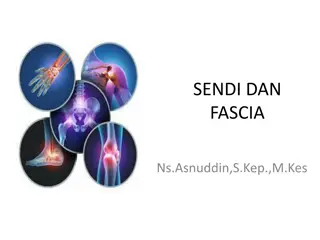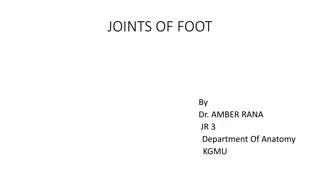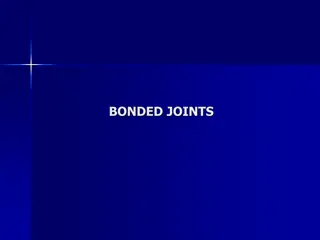Understanding the Anatomy of Elbow, Wrist, and Hand Joints
Explore the intricate anatomy of the elbow complex, wrist, and hand joints through detailed descriptions and images. Learn about the articulations, movements, and stability factors of these crucial joints, as well as the role of peripheral nerves. Gain insights into the unique configurations that contribute to joint stability and function.
Download Presentation

Please find below an Image/Link to download the presentation.
The content on the website is provided AS IS for your information and personal use only. It may not be sold, licensed, or shared on other websites without obtaining consent from the author. Download presentation by click this link. If you encounter any issues during the download, it is possible that the publisher has removed the file from their server.
E N D
Presentation Transcript
ANATOMY OF THE ELBOW, WRIST, AND HAND JOINTS Jane Fedorczyk , PT, PhD, CHT Certified Hand Therapist Jane.Fedorczyk@Jefferson.edu Center for Hand & Upper Limb Health and Performance
Objectives Describe anatomy of the elbow complex including the course of the peripheral nerves. Describe anatomy of the wrist complex. Describe the anatomy of the small joints of the hand.
Elbow Complex: 3 Articulations Ulnohumeral Radiohumeral Superior or Proximal Radioulnar Joint (PRUJ) H C T O RH U R
Elbow Joint Diarthrosis, synovial, hinge Movements = Flexion/Extension Humeroulnar Joint Trochlear notch of ulna and trochlea of humerus Humeroradial Joint Radial head and capitulum of humerus Humeroradial Joint Humeroulnar Joint
Proximal Radioulnar Joint Proximal Radioulnar Joint Synovial, pivot joint , diarthrosis Pronation and supination Radial head and radial notch of the ulna Radial notch also known as lesser sigmoid notch Annular ligament makes it all possible
Elbow Complex: Osteology Lock and Key Configuration Primary to Stability
7 Articular Configuration Adds to Stability C T RH C T CP CP RH
8 Articular Configuration Adds to Stability
One capsule surrounds all joints! Tension from anconeus pulls posterior capsule away from joint lines
Ligaments of the Elbow Ligaments of the Elbow and Forearm Radial/lateral collateral ligament Lateral epicondyle to annular ligament Lateral, fan like Prevents against a varus force Ulnar/medial collateral ligament Medial epicondyle to coronoid process and olecranon Medial, triangular (3 bands) medial epicondyle to coronoid process (anterior); ulna (posterior) Prevent against a valgus force http://doctorhackett.com/tommy-john-surgery/
Lateral Collateral Ligament Complex Lateral Radial Collateral Triceps H Biceps Tendon R U Lateral Ulnar Collateral Annular Ligament
15 Elbow: Lateral Ligaments
Medial or Ulnar Collateral Ligament Complex Anterior Band Posterior Band Transverse Band
Nerves at the Elbow Radial nerve PIN Median nerve DSRN Ulnar nerve DSRN = dorsal sensory radial nerve PIN = posterior interosseous nerve
21 Coronoid and Radial Head Act as a Buttress to Posterior Deforming Forces Imposed by Biceps, Brachialis, and Triceps CP of RH fovea ULNA
FOREARM ROTATION: SUPINATION/PRONATION DRUJ PRUJ
Ligaments of the Elbow and Forearm Ligaments of the Forearm Interosseus Membrane Radius to Ulna Stabilizes forearm Muscle attachments site Pathway for neurovascular structures
ANATOMY OF THE WRIST JOINTS Jane Fedorczyk , PT, PhD, CHT Certified Hand Therapist Jane.Fedorczyk@Jefferson.edu Center for Hand & Upper Limb Health and Performance
Wrist Complex Unlike shoulder, elbow, and forearm, the wrist does not play a primary role in hand placement Provides a stable base to generate force for grip and prehension Provides mobility to accommodate fine adjustments in hand position to achieve optimal length-tension relationships Wrist must tolerate load transmission during prehension and closed chain activities Choose Stability Over Mobility
Major Load Bearing Column CMC II and III Capitate Most of Scaphoid Lunate Distal Radius 70-85% of Load (80%) 40-50% Radioscaphoid Tm Td H C Tr S L 30-35% Radiolunate
Minor Load Bearing Column Distal Ulna TFCC Triquetrum, Hamate CMC IV, V 15-30% of Load (20%) H Tr
Loading the Wrist Load Transmission Altered: Change in length of radius (shortens) or ulna (lengthens?) With Forearm Rotation (pronation) Consequences of Altered Load: Ulnocarpal impingement Carpal instability Degenerative Changes to TFCC, carpal bones (avascular necrosis)
Articulations of the Wrist Radiocarpal Joint Midcarpal Joint Distal or Inferior Radioulnar Joint Note separate joint capsules for each PCR interposed or intercalated between DCR and distal radius
Joints of the Wrist Region Radiocarpal Joint Radiocarpal Joint = Wrist Joint Type of Joint Diarthrosis, condyloid, synovial Articulating Surfaces Distal radius Scaphoid, lunate, triquetrum Movements/Function Flexion, extension, radial and ulnar deviation Considerations Ulna is not part of this joint Stabilized by palmar/dorsal radiocarpal and collateral ligaments
Joints of the Wrist Region Midcarpal Joint Plane, synovial Between proximal and distal rows of carpals Carpometacarpal Joints 2-5 Plane, synovial Between distal carpals and base of metacarpals Intermetacarpal Joints Plane, synovial Between bases of the metacarpals
Wrist Motion Forearm Rotation supination/pronation PRUJ, DRUJ, IOM Flexion Extension Radial Deviation Ulnar Deviation Ruby, 1988 Passive supination of carpus; can t measure
The overall motion in the wrist is the sum of the carpal bones moving on each other, influenced by their articulations, ligamentous attachments, and indirect actions of adjacent tendons. C T S L LT
Location of Movement:RC vs.MC Author Flexion Extension Radial Deviation Ulnar Deviation Kapandji RC>MC MC>RC RC=MC RC=MC Ruby MC=RC MC=RC MC>RC MC>RC Saraffian MC>RC RC>MC Wrist motion occurs at both MC and RC joints About 50/50 split between MC and RC Clinical significance if partial wrist fusion indicated; patient has potential to recover about 50% of motion
Ligaments of the Wrist Separate Joint Capsules Muscle Forces Move Wrist at MC Joint Passive Forces Move Wrist at RC Joint Certain Ligaments Significant for Carpal Bone Stability
Intrinsic Ligaments Attach to carpal bones in same or different row Short Long Intermediate L
Intrinsic Ligaments Carpus is spring loaded like a jack in the box Intrinsic ligaments maintain this architecture The 2 most important intrinsic ligaments are: ScaphoLunate (SL) LunoTriquetral (LT)
Scapholunate Interosseus Ligament (SLIL) Dorsal: strongest; most critical to SL stability; primary restraint during flexion/extension Volar: weaker than dorsal but controls rotational SL stability Proximal: membranous; little consequence to SL stability
Normal Wrist X-ray C S L
SLAC Wrist due to disruption of Scapholunate Ligament SL Dissociation Most Common Carpal Instability (DISI = dorsal intercalated segment instability) C S L
Disruption of Lunotriquetral Ligament 2nd most frequent carpal instability Volar intercalated segment instability= VISI
Extrinsic Ligaments Volar Volar Dorsal
Volar Extrinsic Ligaments Originate from Radius or Ulna and attach to carpal bones All cross RC joint Some cross MC joint Provide stability during wrist motion P RSC
Ulnocarpal Ligaments Ulnolunate (UL) Ulnotriquetral (UT Ulnocapitate (UC) UC UC Anchor the lunate and triquetrum to the ulna stabilizing the ulnar corner of the wrist
Dorsal Carpal Ligaments Dorsal radiocarpal & dorsal intercarpal ligaments play an important role in carpal stability & carpal kinematics Scaphoid stabilizers Viegas, 1999
Distal Radioulnar Joint Distal Radioulnar Joint Synovial, pivot joint, diarthrosis Pronation and supination Ulnar head and ulnar notch of the radius Stabilized by interosseous membrane and Triangular fibrocartilage complex Head of Ulna
DRUJ Distal Radioulnar Joint Distal radius articulates with ulnar head at the sigmoid or ulnar notch Articulating surface of the ulnar head is the seat 75% of the circumference of the head is covered with articular cartilage
Triangular Fibrocartilage Complex Components Intra-articular disc UCL R-U Ligaments Function Supports DRUJ Adds to articular surface of radius Compensates for shorter ulna in load transmission TFCC DRUJ
TFCC Originates from sigmoid notch and inserts into the ulnar fovea and the base of the styloid Includes dorsal and volar radioulnar ligaments, ulnocarpal ligaments, ECU subsheath, and articular disc or meniscus homologue (TFC proper)
TFCC Originates from sigmoid notch and inserts into the ulnar fovea and the base of the styloid Includes dorsal and volar radioulnar ligaments, ulnocarpal ligaments, ECU subsheath, and articular disc or meniscus homologue (TFC proper)























